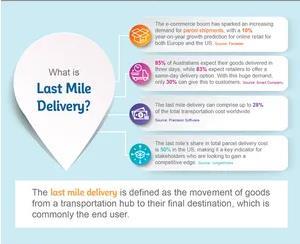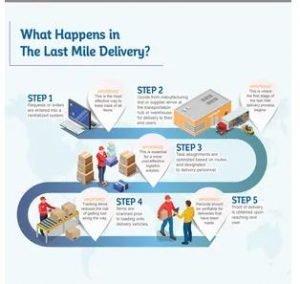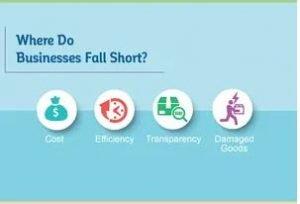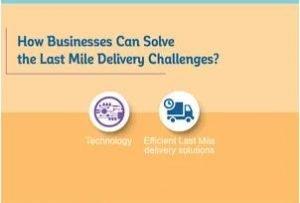Last mile logistics serve as an imperative part in the service cycle of supply chain logistics. Therefore to garner wonderful customer experience steps have to be taken to enhance last-mile innovation. We know that finding progressive solutions has a great deal of potential to improvise supply chain logistics, but professionals in this domain get immersed in the logistics of the last mile connectivity that they overlook the rest.
First Touchpoint Equals Last Mile Logistics
The picking process is typically indicative of the first touchpoint of the cycle. Order details are relayed to pickers after an order has been placed. Pickers choose bins and add products to a box. These boxes are organized and the items that are picked are packaged. This cycle repeats until the shipping occurs. There is always risk involved even if the process functions via robotics. Any error in the first touchpoint could result in delays. Therefore warehouse personnel must look at both sides of the first touchpoint, which is item picking and inbound logistics as to how an item reaches the warehouse/distribution centre.
Find below 7 trends in last mile logistics:
1. Digital-First Will Dictate Last-Mile Service

Firms have to inculcate a digital strategy for the last mile process to grow considerably. Last mile connectivity has been given precedence by most firms is explicit and an undeniable part in supply chain operation. Failure in the last mile can debunk all other steps taken in the supply chain.
Firms aiming to excel in last-mile connectivity should fathom that the real value begins at the very first point. An effective first mile management enhances the entire system. Similarly the value placed on last mile connectivity should complement the first mile or the first touchpoint.
Digitally inclined firms identify the positives of technological innovations and their decisions are impacted by digital enhancements. The new age tech-enabled supply chain entities / freight forwarders compete with large shipping conglomerates to enhance business are deploying platforms to increase transparency and decipher shipping quotes, airfreight and ocean freight booking, shipping and customs documentation, transportation payments, and real-time tracking of international shipments.
Last-mile connect is the epitome of high-quality service for customers. Therefore digitally inclined firms have to take steps to connect with customers during every stage of delivery such as: before delivery, validating delivery, and service after delivery.
2. Procurement Contributes to better Supply Chain Efficiency
Logistics improves with better inbound management. First mile is by far an imperative stage in logistics and involves the highest risk too. Deficient orders and last-minute fulfilment increases the risk of goods going out-of-stock. Failure to take necessary steps could result in both overdoing and underperforming. That is basically inventory management got to be effective.
Supply chain management platforms and Warehouse Management Systems (WMS) optimize inventory and warehouse operations. Focus on actual inbound logistics processes is compulsory.
Replenishment and inbound logistics must emanate from the control point of view. Suppliers and vendors relish reduced accountability and low visibility. Warehouses are in the know regarding what a supplier/vendor does. A WMS can make a positive impact here. WMS integrate with supplier and vendor systems. Those with limited technologies and resources can enable APIs and supportive services via the internet and increase visibility within operations. Hence warehouses gain visibility into inbound logistics such as metrics and KPIs for enhancing supplier performance.
3. Next-Day Delivery will become Light Speed

Nowadays most logistics firms resort to last-mile scramble to complete the cycle. Though presently high speed logistics do not exist, the ability to transform logistics through better efficiency for last mile connect will improve the pace of delivery. Over and above customers have access to information and resources to interact with delivery agents.
Now therefore majority of firms such as Walmart, Target, Amazon have launched pioneering last-mile services to connect with customers and reduce possible delays. One of the most prevalent issues during delivery is non-availability of customers at home. Firms are looking at novel ways on how to overcome such issues to enhance the efficiency of the global logistics industry.
4. A Technology Makeover for the last mile

For shipments requiring extra care, trust Final Mile and White Glove services demand enhanced technology. Though each delivery scan triggers a notification to a customer, this information has not been shared. Instead it is usually maintained within the purview of the carrier's ambit. Carriers traditionally dither to share such information of last mile. Even top carriers that offer last-mile tracking via real-time tracking of delivery vehicles have limited access to such technology.
This year will turn tables around and enhance real-time technologies and capacities to track delivery drivers in their final mile schedule. This will serve among a leading trend in the final / last mile logistics which could further bring in newer innovations to ensue improvements in the supply chain.
5. Retooling of Drayage Logistics For Final Mile

IMO 2020 new rule will impact top trends in last-mile logistics. World's carriers look to cut costs to avoid increased expenses due to the regulation. Vessel size will increase resulting in issues with port management and drayage. Drayage is part of a longer overall move as from a Vessel to the warehouse.
The United Nations' International Maritime Organization (IMO) regulation - IMO 2020 enforces a sulfur cap on the fuels used by marine vehicles to reduce pollution. Larger vessels could be deployed to offset higher operational costs because an increase in ship size does not translate to increase in overall fuel consumption when the load is also proportionally increased. This could lead to congestion and delays as ports struggle to handle massive volumes from larger vessels.
Now the issue becomes intricate to shippers who would be coerced into rethinking last-mile to the dock. And how this could overall lead to delays in distribution and final-mile delivery to the customer's address.
6. Blockchain Will Merge With Last Mile Logistics
Not all have adopted to utilize blockchain, the ledger-based chain will soon grow to become a major USP this year. Global entities have begun taking necessary steps to build open-source blockchain solutions. Firms like Maersk, have joined hands with IT giants IBM to inculcate innovative blockchain capabilities. Blockchain will soon prove its usefulness and supply chain professionals will have to embrace these strategies.

7. Sustainability - The New Driving Force
Progression within the supply chain and last mile connectivity will enhance focus to augment sustainability. The final mile of logistics is one of the most revenue disruptive facets of a supply chain management. As firms aim to improve sustainability, the last mile connect will represent the game-changer for upgradations and savings.
Last Mile Logistics Will Fuse With Reverse Logistics
Another impressive trend in the last-mile logistics this year will involve the blending of final mile logistics and reverse logistics. Giving your customers an amazing shipping experience will be incomplete unless their experience in returning an item has not been taken care of. Retain customers by handling returns seamlessly. Put your customer's fears at rest by showing them how prepared you are in dealing with the returning of a product.
Last mile logistics is wherein a client may opt to return an item. Therefore final mile could theoretically turn into first mile of reverse logistics. Firms are looking at how to reduce delays in return management and improve reverse logistics. These can be enabled by identifying damage-free products that can be repackaged and shipped, so as to avoid restock of goods.
Deliver on Higher Expectations by Implementing Latest Trends
Shippers need to deliver as per expectations and accomplish more successful last-mile deliveries. By aligning with these trends in last mile logistics as stated you can attain success, build relevant customer interactions, and derive greater value from your supply chain.


